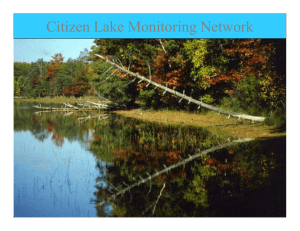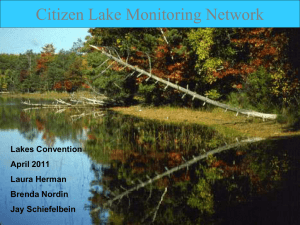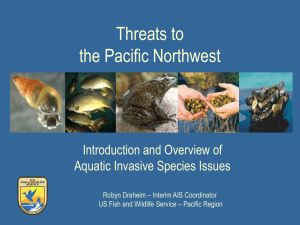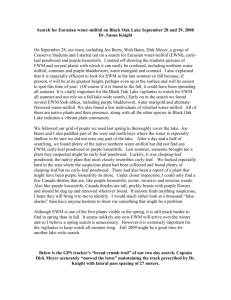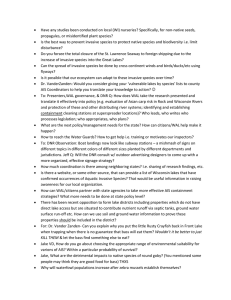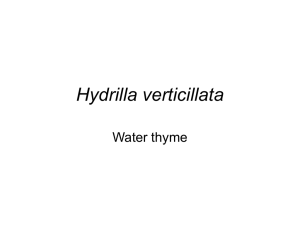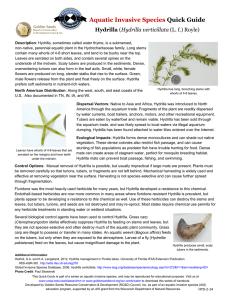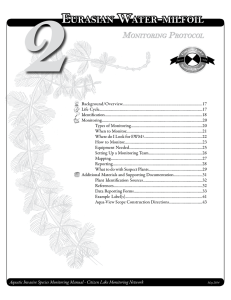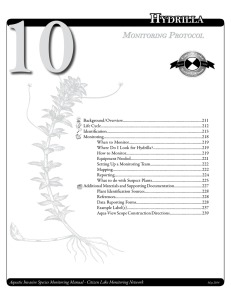Eurasian Water-milfoil
advertisement
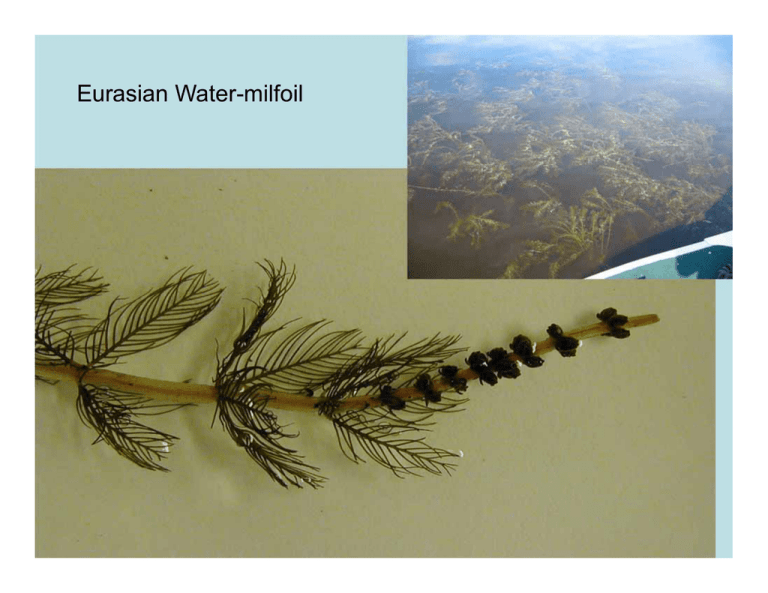
Eurasian Water-milfoil Exotic Eurasian Water-milfoil • 11 Native Species of Water-milfoil in USA • 7 Native Species of Water-milfoil in WI • EWM Native to Asia and Europe • EWM Arrived in US in 1942 & WI in 1960s Out Competing Native Plants • Reproduces by seeds, runners & fragmentation • Begins to grow at colder temperatures and lower light levels • Possesses canopy growth pattern • Not susceptible to native pathogens EWM •Early spring – late fall •Fast grower •Up to 20 feet tall •Distance between whorls •Lower leaflets same length •12-21 leaflet pairs •Pink coloring at tip •NO WINTER BUDS NATIVE Eurasia watermilfoil will form monoculture stands. Plants can be 20 feet tall AUTOFRAGMENTATI ON Northern watermilfoil on left Eurasian watermilfoil on right Native milfoils form turions Map the milfoil beds. •Is it an isolated bed? •Is it over the entire lake Curly-leaf Pondweed Curly-leaf seeds and turions uagga on the left and zebra mussel on the right. ote the round hinge edge on the Quagga as mpared to the flat hinge area on the zebra mussel. Quagga mussel on the left and zebra mussel on the right. Spiny and Fishhook waterfleas Size comparison of native zooplankton and spiny waterflea Citizen Lake Monitoring Network Lakes Convention April 2011 Laura Herman Brenda Nordin Jay Schiefelbein Wisconsin’s Lakes are Changing Faster than Ever: Algae blooms (phosphorus pollution) Destruction of shoreline habitat Invading plants and animals Steve Carpenter 2004 Differences Between CBCW & CLMN Protecting lake from AIS Checking to see if AIS is in lake Preventing AIS from Some defined monitoring times spreading to another lake Defined hours (high use periods) A lot of contact with public Monitoring along shoreline near landings (based upon AIS monitoring for) Minimal contact with public Monitoring along shorelines, beaches, shallow water areas, & deep water areas Casual observer vs True Monitor Casual Observer vs Trained Monitor Casual observer Trained monitor More general observer (simplified training) Do not follow protocols Volunteer selects species they monitor for Often do not do data entry Seldom report if they do NOT find AIS Examples ‐ Shoreline sweep Chain of Lakes volunteers Lake meeting presentations More technical training (longer & more detailed) Monitoring follows standard monitoring protocols (meshes with DNR protocols) Volunteer selects species they monitor for Enter data into SWIMS Report if they do NOT find AIS Manual components • Contacts • Section 1 – Getting Started • Sections 2-11 monitoring by Species – – – – – Overview of each species ID tips Monitoring protocols by species Data entry Herbarium labels & equipment building directions as needed – Reporting forms • Section 12 monitoring for the native water-milfoil weevil What other equipment/materials will I or might I need? • A rake, either one or two sided, on a rope or on a pole. • An underwater view scope • Waders or hip boots • Snorkeling gear • A boat • Crayfish traps, nets, zebra mussel substrate sampler, beetle rearing materials, weevil sampling gear • Identification & information pamphlets Setting up a monitoring team •Designate a contact person •Obtain a map •Divide up the work •Report the findings Contact person •Coordinates monitoring •Makes sure entire lake is covered •Checks on volunteers to see how monitoring is going •Vouchers plants •Takes “suspect” plants in to LWCD, UWEX, or DNR •Complies data Obtain Lake Maps •DNR •Fishing Hot Spots •Bait Shops •Web sites Divide up the Work (examples) •Have volunteers monitor 1-mile of shoreline •Shoreline Weed Action Team (SWAT) •Have volunteers monitor specific species •Volunteers without boats can do beach monitoring or zebra mussel monitoring •Bring in Bait Dealers to “store” plants •Maps for lake users to mark where they found suspect plants Report Findings •Let people know what your results are •Newsletters •News articles •County Land & Water Conservation Dept. •DNR, UWEX, GLIFWC •Surface Water Inventory Management System (SWIMS) When to monitor •Native plants – June through August •Eurasian water-milfoil – May through October •Curly-leaf pondweed – May through July •Purple Loosestrife – July and August •Rusty crayfish – June through August •Zebra mussels – Ice out to ice on •Mystery snails – Ice out to ice on •Waterfleas – June through September •Freshwater jellyfish – Aug. through Sept. •Hydrilla – May through October •New Zealand mudsnail – Ice out to ice on Where to look •Beaches •Launches •Marinas •Camps •High use private landings •Inlets •Entire Lake Loosestrife Watch Program Where to Look • Roads • Hiking trails • Lake Shore • Streams Raising Galerucella Beetles DIGGING PLANTING GROWING Host plant roots are dug up and planted in pots. Pots are covered in netting to protect the loosestrife beetles from predators. Beetles are added once the plants reach 2 feet tall. Beetle larvae damage on host plant Rusty Crayfish Impacts from Rusties • • • • • Destroy native plant beds Eat fish eggs and macroinvertebrates Outcompete native crayfish Hybridize with native crayfish Really hard on native snails especially if the lake has the non-native Chinese mystery snails. Regulations When Collecting Crayfish •Fishing License or Small Game License •Cannot have fishing gear •Traps •Trap dimensions – length and width •Opening size •Netting •Net size •Have to be lifted vertically Banded, brown and Chinese mystery snails (brown mystery snail is native to Wisconsin) Brown Mystery Snail – Native to Wisconsin •Adults rarely reach 1.5 inches in height •No bands •Have hard operculum Chinese Mystery Snail •Adults are over 1.5 inches in height •No bands •Have hard operculum Banded Mystery Snail •Adults are up to 1.5 inches in height •bands •Have hard operculum Freshwater jellyfish Wisconsin’s Success Story! Hydrilla verticillata Hydrilla turions showing scale Hydrilla specimen is a preserved specimen – that is why it is so pale. Hydrilla above is from the pond in Marinette 2007 Hydrilla showing whorls Marinette Pond Hydrilla 2006 Marinette Pond 2007 (same location) Upper left: Hydrilla Above: Brazilian waterweed (Egeria) Left: Elodea Canadensis New Zealand mudsnail •St Louis River harbor (Duluth Superior Harbor) and near Milwaukee •Densities up to 500,000 / meter2 •Asexual reproduction •Wide tolerance range •Brackish to fresh waters •Lives in estuaries, lakes, rivers & streams •Tolerates waters with high & low calcium •Found on soft and firm substrates •Inhabits turbid and clear waters •Tolerates water from 320 to 800 F •Does well in eutrophic waters New Zealand Mudsnail •1/10 to ¼ inch high •Operculum present •Light to dark brown •Cone shaped shell with 5-6 whorls •Raised carina (keel) on whorls Carina Eurasian water-milfoil Weevil Monitoring Euhrychiopsis lecontei • Weevils are native to the US • Weevils eat native watermilfoils but prefer EWM • They may produce several generations in a season • Weaken EWM growth and vigor, often causing it to collapse in the lake • Overwinter in undisturbed shorelines. Tailor the program for the volunteers. Data entry pilot (2012?) • I-Phone & Palm pilot technology Pros •Uses the infrastructure we have set up in SWIMS (security, etc.) •Can avoid programming for specific brands of phones •Would automatically work for all of our data entry forms (Secchi, AIS, River monitoring, Loons, etc). •Cost to develop would be minimal Any Interest? Cons Would require user to have • phone/PDA with a Data Plan & Access to a 3G network or Wi-Fi •3G coverage will be more widely available & more folks will have the phones by the time we have pilot complete •Sometimes a 3G network would NOT be accessible @ a landing. Inspector would have to resort to paper/entering the data later •A phone & data plan costs money. Newer Invasives to Wisconsin • Red Swamp Crayfish • Brazilian Waterweed • Yellow Floating Heart Red Swamp Crayfish • • • • • • • • Dark red in color (a genetic mutation may turn the body and/or claws blue) Raised bright red spots covering the body and claws Black wedge-shaped stripe on the top of the abdomen Vary in length from 2 to 5 inches. Prefer marshes, swamps, ponds and slow moving rivers and streams, but have become established in lakes. They are tolerant of fluctuating water levels and can survive long dry spells by remaining in burrows or crawling over land to other water sources. Mate in autumn and lay eggs in spring to early summer. The number of eggs varies with the size of the female, (as many as 650 eggs at a time). Distribution in Wisconsin in 2009 - ponds in German Town, Washington Co. and City of Kenosha, Kenosha Co. Brazilian Waterweed • • Stems can reach 15 feet in length. Leaves arranged in whorls of 4-6 leaves. Leaves are ¾ - 2 inches long & serrated. • Leaves are attached directly to the stem. and often curve downwards. • Adventitious roots are freely produced on the stem. • Plant Reproduces by stolons & stem fragments. • Plant forms dense mats. It can out compete Eurasian water milfoil. Look-alikes: hydrilla (AIS) and our native waterweeds (Elodea canadensis & Elodea nuttallii) Brazilian waterweed, a top selling aquarium and pond plant, is often sold under the name Anacharis and is also known as Brazilian elodea or "oxygenating plant". It is believed to have been introduced in the United States by the aquarium trade. Found in one pond in Portage Co. Yellow Floating-Heart • • • • • • • • Circular to slightly heart shaped floating leaves are 1-6” in diameter. Leaf edges are slight wavy or scalloped Leaves are green to yellow-green above, and are often purple underside Yellow flowers arise above the water surface The fruit is a ½-1” beaked capsule that contains many flat, seeds with winged margins (which help with floatation and attachment to avian vectors) Prefers slow moving rivers, lakes, reservoirs and ponds, but can also grow in damp mud, swamps and wetlands. Look-a-likes - water lilies, Spadderdock and Watershield Yellow-floating heart is a popular water garden plant. In areas where it has been introduced, it has often become the dominant plant species. Yellow-floating heart is very difficult to control due to its ability to form a new plant from rhizomes, stolons, separated leaves, or seeds.
